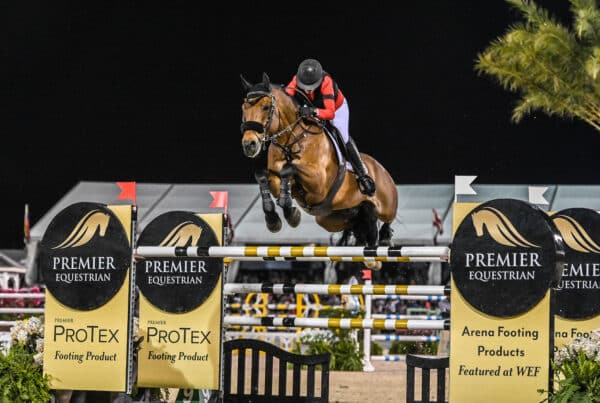Are you considering making the investment in new footing for your horse arena? We’ve gathered everything you need to know about horse arena footing products, such as geotextile arena footing, why they’re important, and the key factors for textile footing that will contribute to the overall success of your Premier Equestrian arena.
WHAT IS TEXTILE FOOTING?
Textile footing is composed of different types of recycled flats and fibers that are applied to the arena’s top layer. While there are a variety of textile footing products, many are either chopped or shredded, such as our popular footing products Premier ProTex and ArenaAid. With the proper application, these textile footing products enhance the right type of sand to make it tighter, more stable, and safer for your horse to ride on. Adding textile footing also prevents over-compaction in the arena. Both products can be mixed with new or existing sand to increase the performance in the arena without the added cost of replacing all the sand.
WHAT DO TEXTILE ARENA FOOTING PRODUCTS DO?
Textiles and fibers retain moisture and stabilize arena sand by binding loose particles. Fibers mimic the effects of a grass rooting system. The horses’ hooves ride on top of the surface rather than in it. These textiles and fiber materials require a specific blend of sand, as well as water and specific grooming equipment.
WHY IS TEXTILE ARENA FOOTING IMPORTANT?
“When mixed with the proper sand, textile footing ultimately creates the safest surface for your horse,” says Chris Neihart, Vice President of Premier Equestrian. “For over a decade, we have been studying how equestrian arena surfaces interact with horse biomechanics. Our footing products are designed to enhance and compliment different qualities of existing and new arena sand to benefit horse performance and prevent injury. Our textile footing products aid in stabilization, moisture control, and impact absorption when mixed with your unique sand.”
The benefits don’t stop there. Regardless of the discipline, equestrian textile has many benefits, some of which are:
- Textile footing reduces dust – Fibers from the geotextile arena footing cling to water and sand, effectively reducing the amount of dust in outdoor and indoor arenas.
- Prevents injuries to horse and rider – Installing proper equestrian textiles for footing in an arena ensures more stability for the horse, which means more safety for horse and rider.
Improves traction and cushioning – Textile footing improves traction and cushioning for the horse, which means less chance of slipping when running, jumping or turning.
3 THINGS YOU NEED FOR ARENA TEXTILE FOOTING:
1. SAND
The most important component to good textile footing is the right type of sand. “Many people don’t realize the science behind sand and material selection,” notes Neihart. “For example, textile footing additives require an angulated particle shape and a sand that is well-graded and especially fine. Without these specific characteristics, textiles won’t be able to perform correctly.”Sand is the key ingredient in all good riding arena footing. Choosing the wrong sand can create major problems and is a very expensive mistake. We’re happy to offer a free sand analysis and sand report to help guide you through this process.
2. WATER
The second component needed for textile footing is the ability to water consistently. The correct surface moisture is what holds the sand and the fibers together. As arena footing starts to dry out, the sand has a tendency to fall away and the textiles start to separate. “When I see a separate layer of textile on top of a separate layer of sand, I know that client has a watering problem,” says Neihart. Keep in mind that the right textile footing can often help retain moisture, however proper watering is still a necessary component to proper footing.
3. GROOMING
The third and final component of a successful textile footing is having the correct type of arena grooming equipment. Arena drags and groomers are needed to keep the footing flat, properly blended, and ridable. The more evenly the sand and fiber are mixed, the better the surface is for riding. Better riding means getting more performance from your horse and providing a safer surface to ride on.
A proper groomer is responsible for keeping the sand and fibers mixed together, eliminating hoof prints, ruts or tracks that have developed. “We’ve designed our groomers to specifically maintain textile footing,” says Neihart. “Premier Groomers utilize both S-tines and coil tines that lift and blend the surface materials together, then the roller on the back finishes and smooths the surface flat.”We’ve designed a full line of Premier Equestrian arena drags and groomers to suit a variety of budgets and needs. Visit the Horse Arena Maintenance section of our website to learn more about our grooming products, get an overview of their various features, and compare groomers to find the right one for your equipment and arena size. We’ve also got a helpful footing installation video and a tutorial with all the information you need to know about horse arena sand.
At the end of the day, there’s a lot that goes into good horse arena footing, but it’s relatively simple to improve your arena surface when you understand the components involved. Building an arena correctly is one of the best investments you can make for you and your horses. Schedule a free consultation and let us help you design the horse arena of your dreams!
ALL CONTENT COPYRIGHT 2022 PREMIER EQUESTRIAN











Thanks for pointing out that the right kind of sand is crucial for a good horse arena to be built. For a long time now, I’ve been thinking about taking care of livestock once my hobby farm becomes a lot more stable. Perhaps I should consult a horse arena building service to see how viable it is for my property.
Hi Alice,
Thanks for your comment! We’d be happy to help you and answer any questions you may have when the time comes.